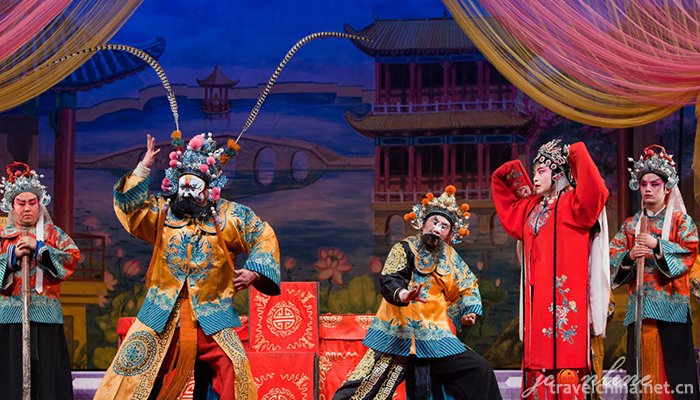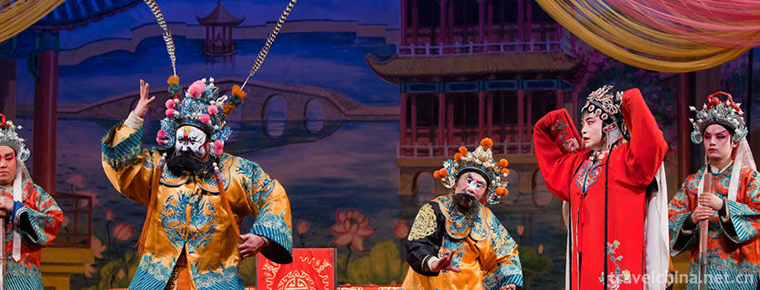Shangdang Laozi
Shangdang Laozi
Shangdang Laozi is one of Shanxi local operas. It is a kind of opera popular in southeastern Shanxi. Shangdang Laozi is a tributary of Wu'an Laozi in Hebei Province. During the Daoguang period of the Qing Dynasty, Wu'an Laozi flowed into Licheng. After that, it merged with local languages and folk songs and gradually developed into a kind of opera with Shangdang's local style. In the course of development, different classes were influenced by Shangdang Bangzi and Puzhou Bangzi respectively, so during the Qing Guangxu period, Shangdang Laozi formed two art schools, the South Road and the West Road. The latter two schools drew lessons from each other and gradually unified their styles.
On June 7, 2008, Shangdang Laozi, declared by Lucheng and Licheng Counties in Shanxi Province, was listed in the second batch of national intangible cultural heritage lists with the approval of the State Council.
Heritage serial number: 699 IV-98.
historical origin
The falling son of Shangdang originated from Wu'an falling son of Hebei Province. During the reign of Qingdaoguang, folk songs and Shangdang Bangzi's artistic nutrition were absorbed and formed.
During the Tongzhi period of the Qing Dynasty, a righteous class was organized in Luhe Village, Lucheng County, and the "beating dike circle" was put on the stage. After Shangdang Laozi moved to the stage, in order to compete with Shangdang Bangzi for audiences, Wang Sihu (also known as Han Baotai) was invited to teach in Guangxu Decade (1884) from Hebei Province for many years, which enabled Li Chenglaozi to develop both in content and form, from performing only minor folk life plays to performing major Dynasty plays.
In the 28th year of Guangxu (1901), artist Wang Sanhe brought Pu Opera performing skills back to Shangdang area, and absorbed Wu Opera skills such as "Sanchakou" of Hebei Bangzi, which enriched the opera items and improved the music singing and performing arts. His activities were extended to most parts of Shangdang and Linfen, Taiyuan, Ruicheng, Yongji, Yonghe, Daning, Shexian, Wu'an, Cixian and Hehe. Nanlin County, Yanchuan, Shaanxi Province and other places. From Guangxu 28 (1902) to the Republic of China 24 (1935), there were more than 20 class societies in Licheng, Lucheng, Huguan, eldest son, Tunliu and southern Shanxi, such as Catching Classes, Xingsheng Classes and Pingsheng Classes. More than 100 performances were frequently performed and the types of plays were flourishing.
During the 27 years of the Republic of China (1938), Wang Congwen organized performers in Licheng to compile new plays reflecting the life of the anti-Japanese struggle and put forward plans for the reform of drama to the superior leaders. In the 28 years of the Republic of China, with the support of Rong Wusheng (Rongzi), Commissioner of Shanxi Five Commissioners'Office, and Wang Xingrang, head of the Central District of Ruling by the President of Yimeng League, an anti-Japanese theatre troupe was established, which mainly produced and performed more than 10 new plays, such as The Eighth Route Peaceful Pass, The Great War Shentouling, Tianjin Wei, Wang Ren Guo, Women Kill the Enemy and Taierzhuang. In the 31st year of the Republic of China, the Anti-Japanese Theatre Troupe was incorporated into the Tainan Victory Theatre Troupe. It continued to rehearse the repertoire "Anti-Sweep", "Spring Farming Movement" and "Double Turn" which cooperated with the anti-Japanese struggle, rent reduction and interest reduction, and self-saving production. Wang Congwen won the title of first-class model dramatist at the Taihang Cultural and Educational Conference held in May, 34, because of his outstanding achievements in reforming drama.
From 29 to 38 years of the Republic of China, the professional troupes of Dropping Opera were formed successively, including Changzhi Victory Troupe, Tunliu Jianghe Troupe, Licheng Dawn Troupe, Lucheng Mass Troupe, Pingshun Peasant Troupe and Huguan People's Troupe. They rehearsed Blood and Tears Enemy, Baimao Nu, Wang Gui and Li Xiangxiang, Wang Xiulu, Chiye River, Shicunjin and Entrap. In addition to their activities in the countryside, the troupe often performs consolation performances for the army.
In 1950, the Tunliu Jianghe Opera Troupe reformed the performance, music and make-up of the opera, transplanted and rehearsed "Liang Shanbo and Zhu Yingtai" to perform successfully in Linfen, with a great reputation. Under the influence of this reform trend, Gaoping, Huguan, Qinxian, Xiangyuan and other places have also established the Laozi Opera Troupe.
Traditional drama
According to statistics, by 2003, there were more than 200 traditional plays by Shangdang and Laozi. Frequently staged and influential among the masses are the new historical plays of Daluying, Xia Bian Ting, Soudu Fu, Misonglin, Yuanmen Chopper, He Hou Dao Dian, Sanguan Pai Banquet, Tea Bottle Design, Cheng Ying Jiu Gu, Zhu Yuanzhang's Chopping His Son, the Sui Palace Case, the ancient costume serial play of the civet cat for the Prince, and the old costume. LianBen Opera, Drunken Chen Bridge Traditional Opera, Zhongbao (Erjin Palace) Traditional Opera, LiangLangshan Traditional Opera, Six Langs Recruitment Traditional Opera, Wenwang Visiting Xian Traditional Opera, Simazhuang Traditional Opera, Curse Hall Traditional Opera, Chopper Traditional Opera, Chongyuan Traditional Opera, Women on Tuwei Modern Opera, Ugly Sister Modern Opera, Sun Flowers Modern Opera Modern Opera Selection of "Wisdom Take the Prestige of Tiger Mountain", "Red Lantern Record", "History of a Revolutionist Painfully", "Title of the Golden List" Small Opera, "Secretary's Residence" Small Opera, "Boil Brain Feeling" Modern Small Opera, "Cuncaoxin" Modern Small Opera, "Dismantling Photo Wall" Modern Small Opera, "Setting Plan", "Deep Mountain Asking Pain", "Striking Tiger Up Mountain", Blood Sword, Gan Lusi Temple, Shengong Youyuan, Dou E's Injustice, Success or Failure Xiaohe, Yang Qiniang, Pair Guns, Zhao Ershe Dengji, Luoyang Hui, Golden Sister, Huai Duguan, Jiyangguan, Zhongbao Recruitment, Burning Qinggong Building, Mu Guiying's War on Hongzhou, Cheng Biaojin Recruitment of Kinship, and other new historical plays, Dajiao Queen, Sanguan Mingyue and Sanguan Mingyue. "White T-shirt" and modern drama "Huairezi", "Maple Leaf is Red" and so on.
Famous actors
Wang Sanhe, Li Fusuo, Hu Yuzhen, Wang Zhaorong, Yang Fulu, Wang Xiancai, Hao Yi,
Xu Xitang, Wang Hucheng, Li Cuihua, Li Minquan, Li Shan, Wang Fengfeng, Wang Zhimin, Shen Zhiping, Yuanhe Liang, Zhang Yingying, Han Baoyu, Zhao Mize, Cui Jinzhu, Songshaniu, Hao Pingzhi, Guo Ming'e, Fu Yongliang, Wei Xiaoma, Liu Zhifang, Song Mingsheng, Wang Wanli, etc.


-
1.Taiyuan Qingxu Baoyuan Old Vinegar Workshop
Taiyuan Qingxu Baoyuan Old Vinegar Workshop is located in Taiyuan City, Shanxi Province. It is the "Taiyuan Youth Heritage and Education Base". It has been awarded the "First Industrial
Time 2019-02-13 -
2.Pearl Lane
Zhuji Lane, located in Zhuji Village, Zhuji Town, Nanxiong City, Guangdong Province, covers an area of about 3 square kilometers. Zhuji Ancient Lane is one of the national 4A scenic spots and one of t
Time 2019-03-20 -
3.Danzhou tune
Danzhou tune is a traditional folk song which only spreads in Danzhou of Hainan Province and has a unique regional style. It is sung in Danzhou dialect with a lively rhythm
Time 2019-04-25 -
4.Lantern Dance
Lantern dance is a Chinese folk dance with a long history. It has been performed mainly on Lantern Festival for at least 1,000 years. Lantern dance originated from Lantern Festival and its production
Time 2019-04-26 -
5.Making Skill of Roe Skin of Oroqen Nationality
The Oroqen nationality is one of the minorities with the smallest population in Northeast China. Because of the influence of living environment and customs, people of the Oroqen nationality
Time 2019-04-28 -
6.Gongs and drums
The Gong and drum books used to be called "Taibaoshu", "Taibao" is derived from the activities of "Taibu" in the countryside of Shanghai suburbs and counties, which seeks
Time 2019-05-15 -
7.Miao Series Slope Cluster
Miao Series Slope Club refers to the festival activities of villages and villages in Rongshui County, Guangxi Zhuang Autonomous Region during the period from the third to seventeenth day of the first
Time 2019-06-05 -
8.Shangdang Laozi
Shangdang Laozi is one of Shanxi local operas. It is a kind of opera popular in southeastern Shanxi. Shangdang Laozi is a tributary of Wu'an Laozi in Hebei Province. During the Daoguang period of the
Time 2019-06-13 -
9.Jihua Temple Music
The music of Zhihua Temple and Beijing originated from the music of court etiquette in Ming Dynasty. It is the only kind of music inherited from generation to generation in China's existing ancient mu
Time 2019-08-03 -
10.Daofu steamed bun with beef and mutton
Steamed bun with beef and mutton is a special traditional delicious food of Hui nationality. It is famous at home and abroad for its strict selection of materials, cooking essence, rich nutrition and mellow taste. The eating method of beef and mutton steamed
Time 2020-12-06 -
11.Suining secondary industry
In 2019, the city's industrial added value will reach 49.158 billion yuan, an increase of 8.7%, contributing 50.7% to economic growth, and boosting economic growth by 4.1 percentage points. The number of Industrial Enterprises above Designated Size reached 573
Time 2020-12-16 -
12.Guangan primary industry
In 2019, the sown area of grain in Guang'an City is 287000 hectares, and the total grain output is 1.8 million tons, an increase of 1000 tons or 0.04%. Among them, the rice output was 1.047 million tons, down 0.4%; the corn output was 448000 tons, an incre
Time 2020-12-19